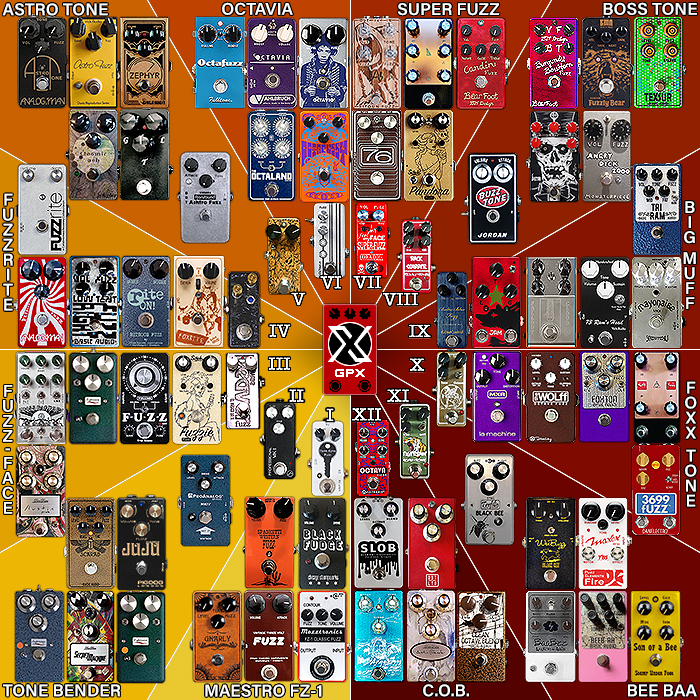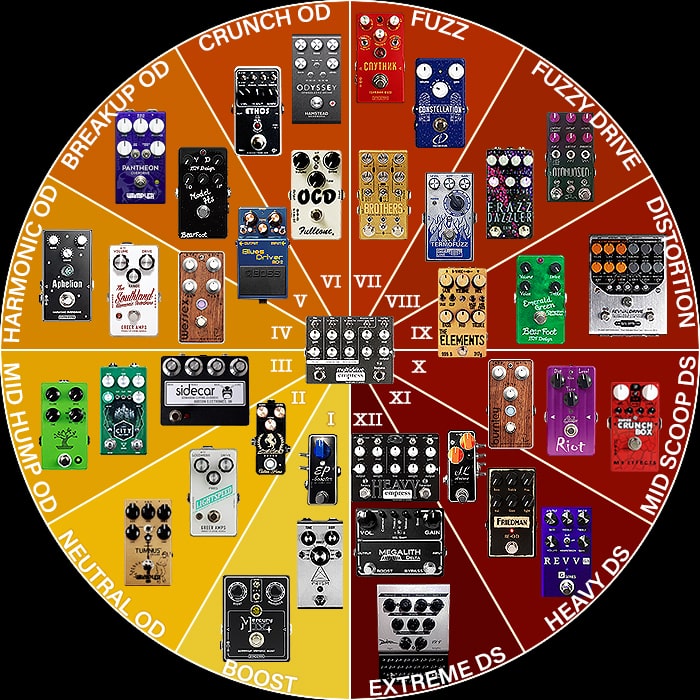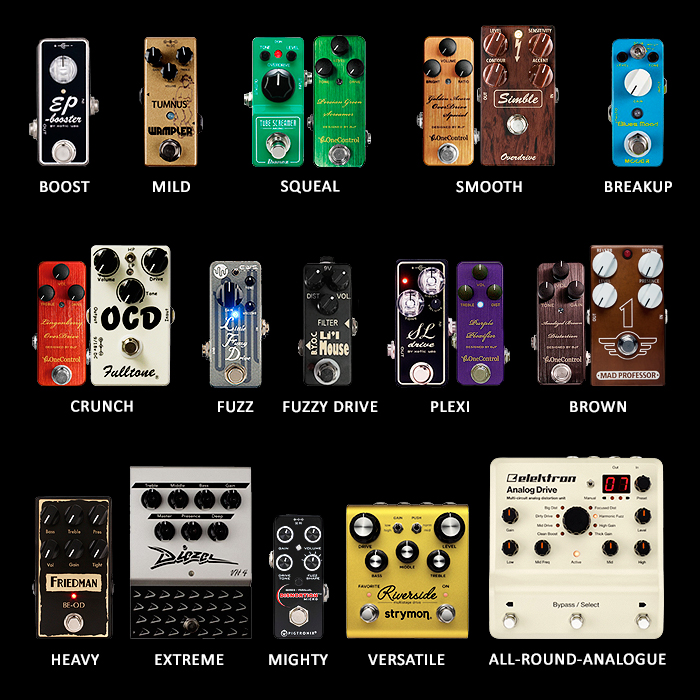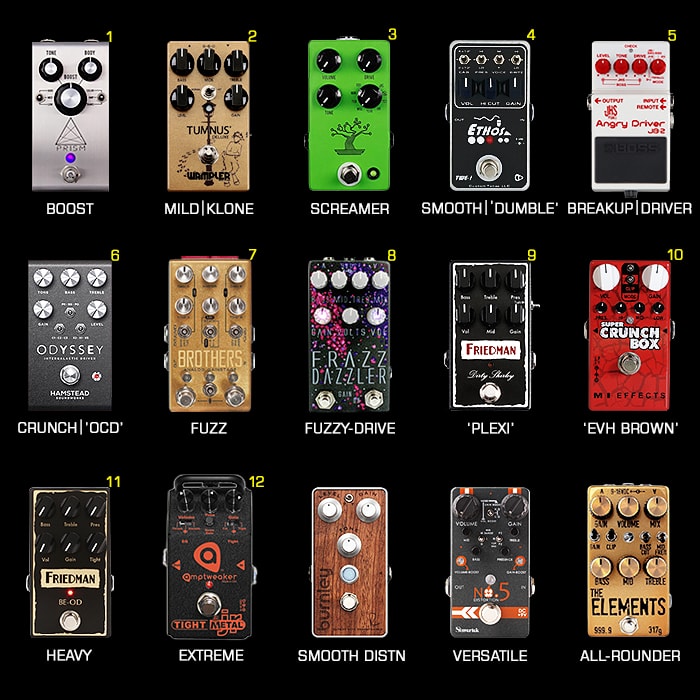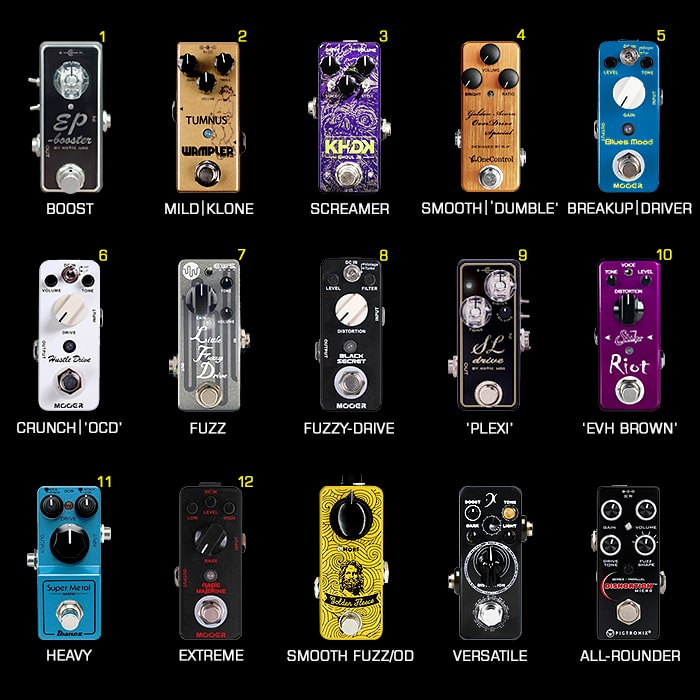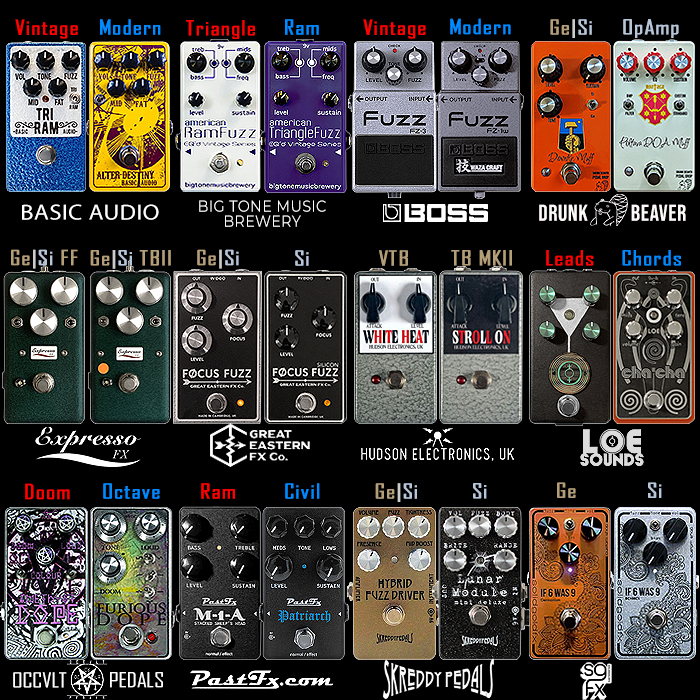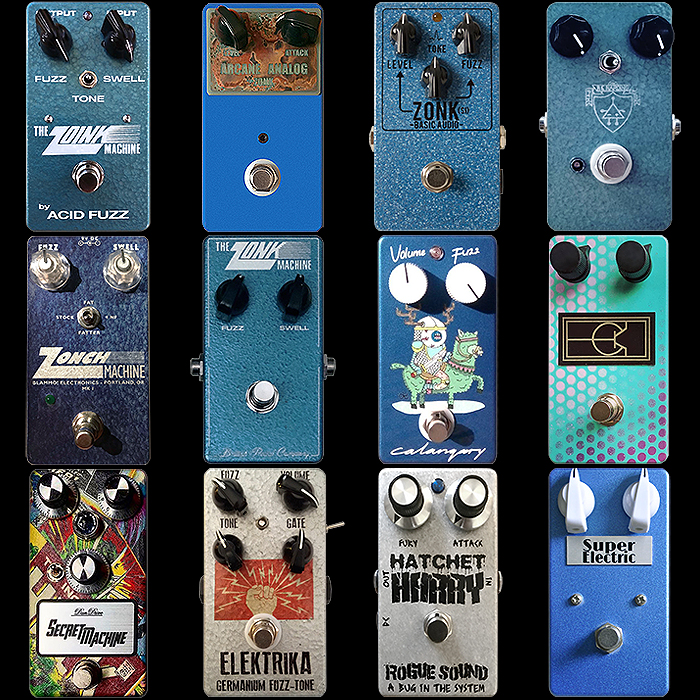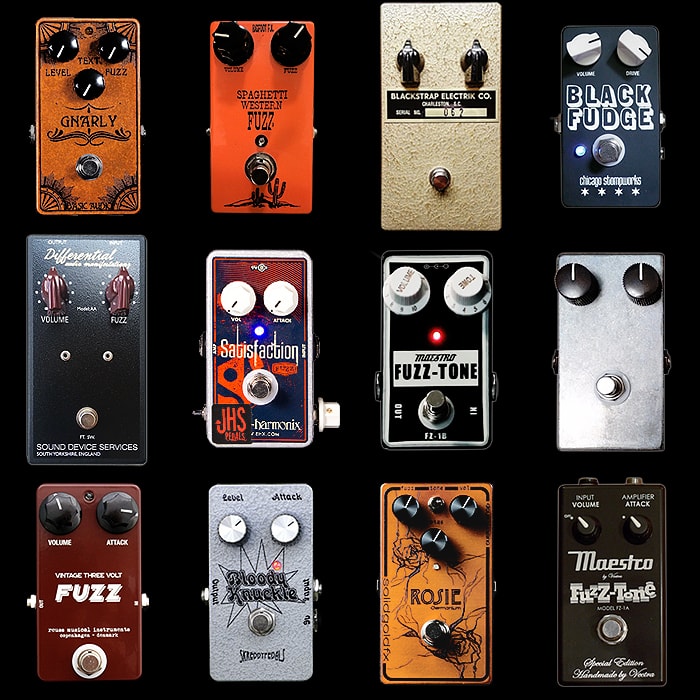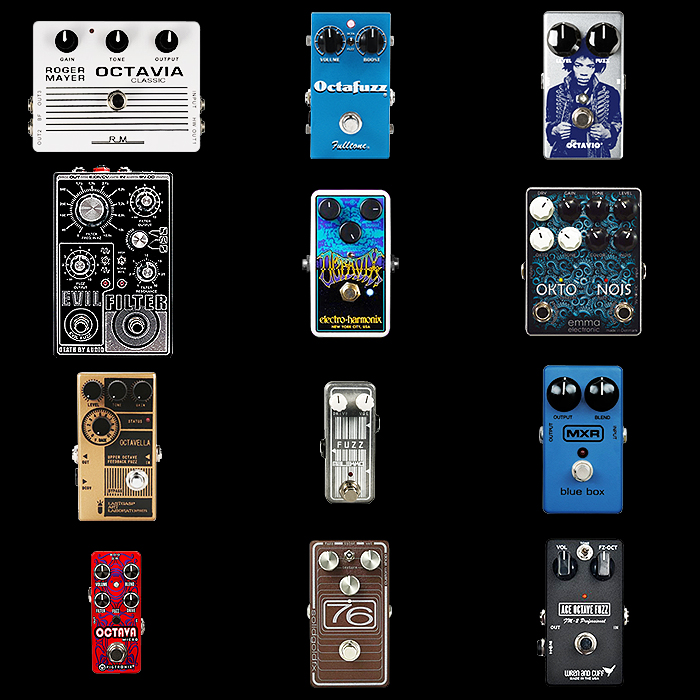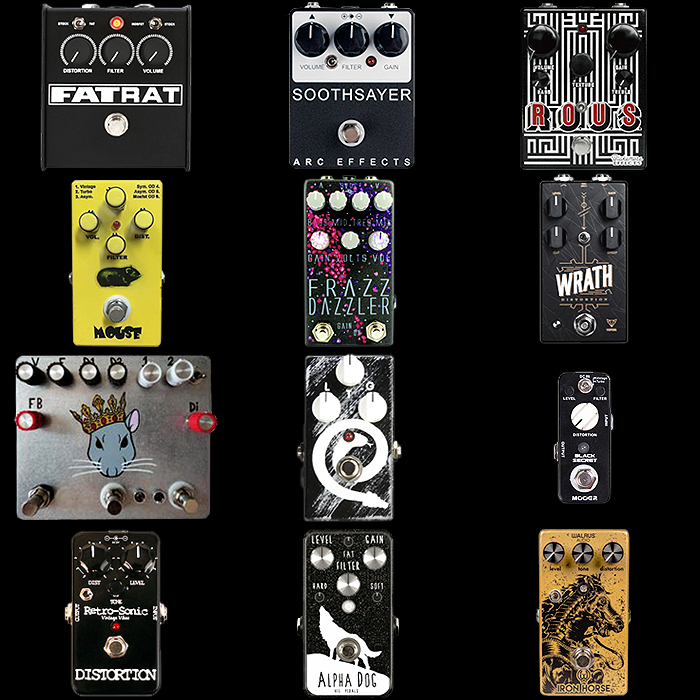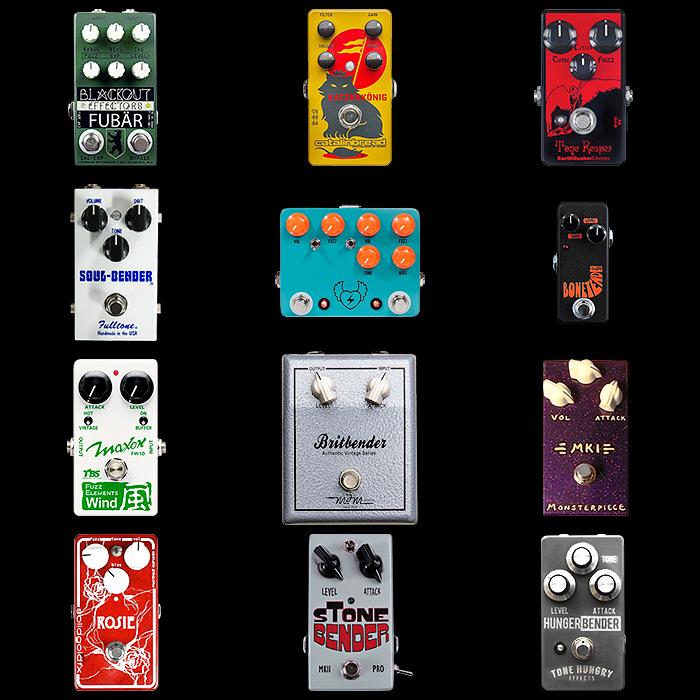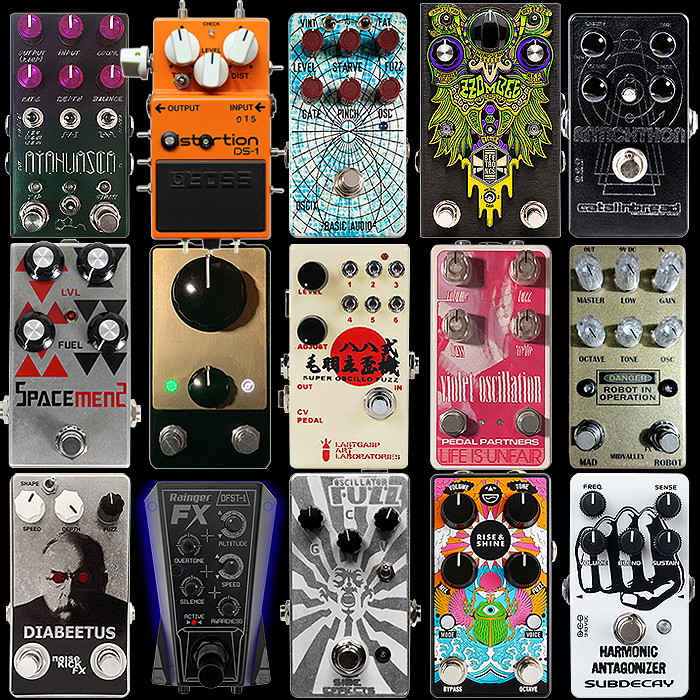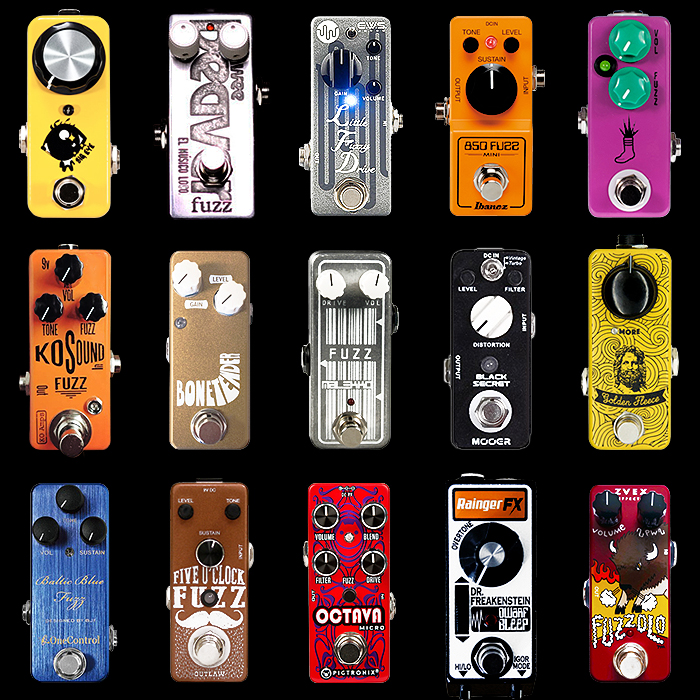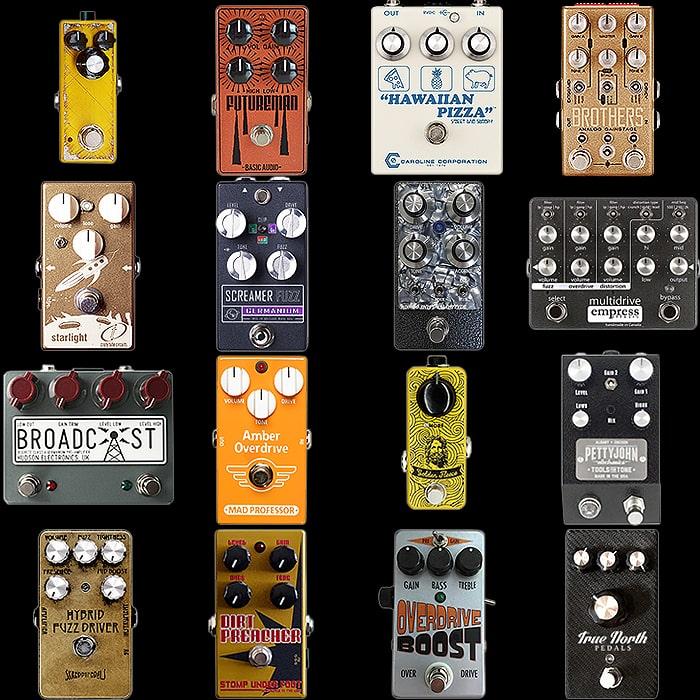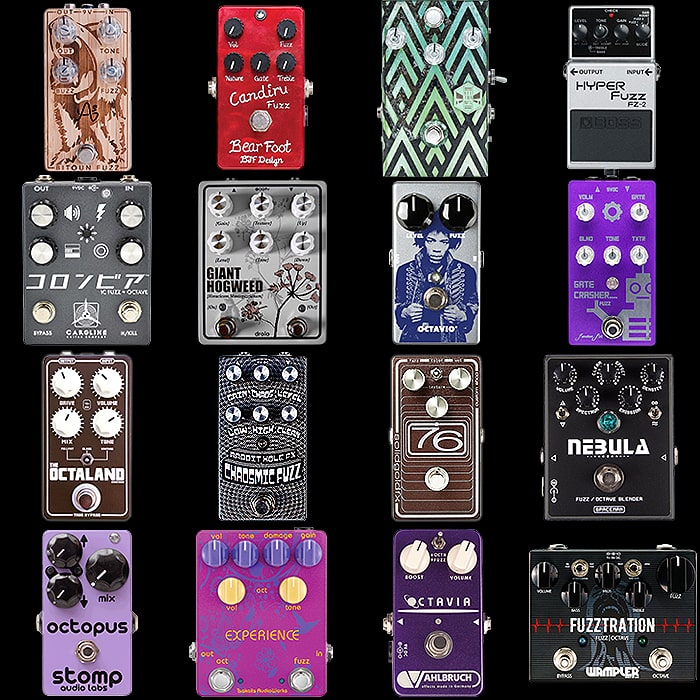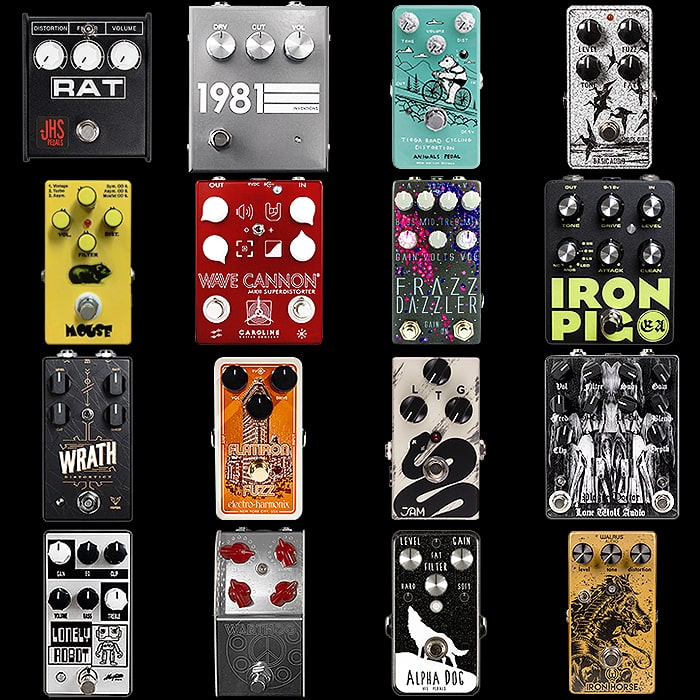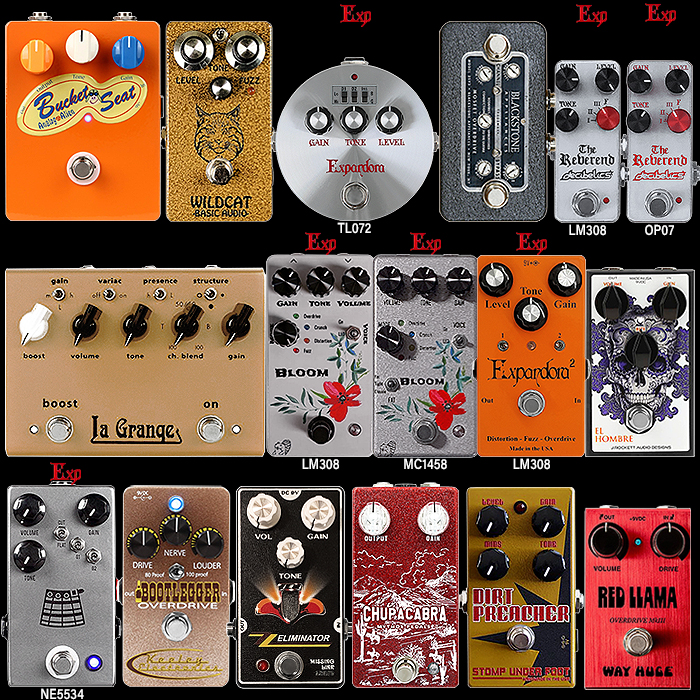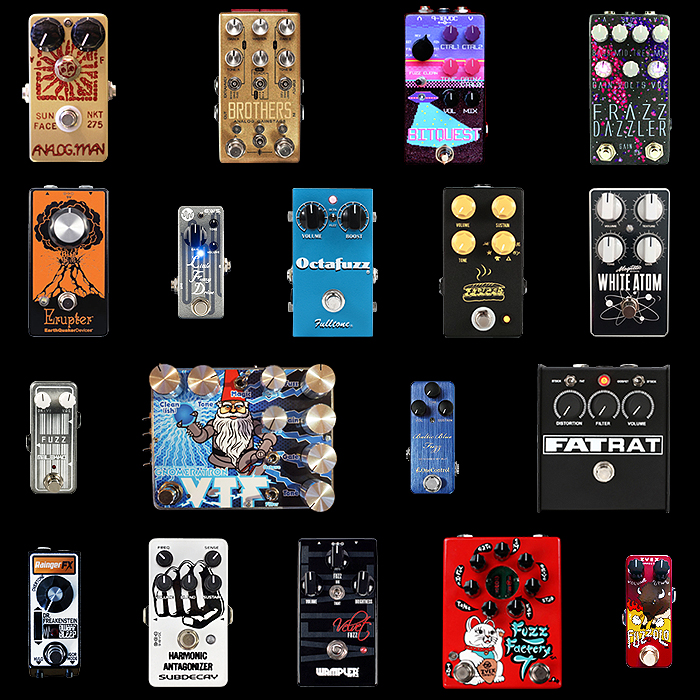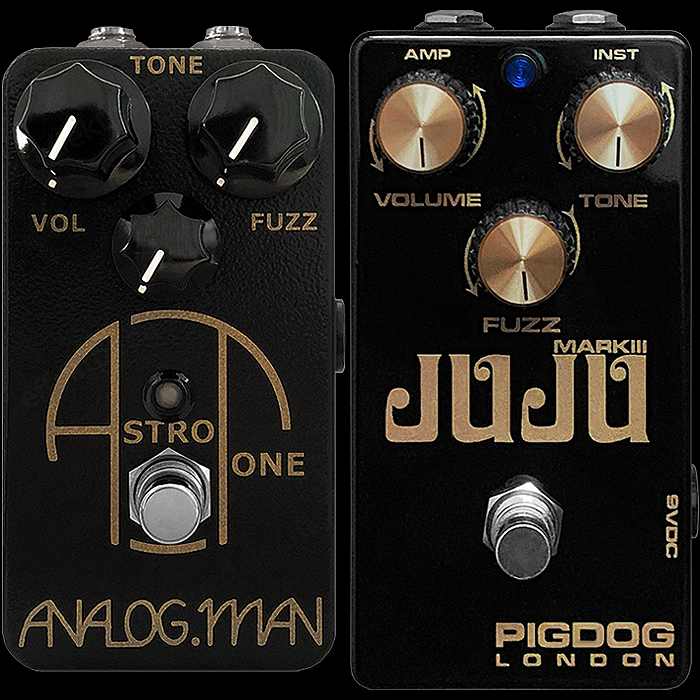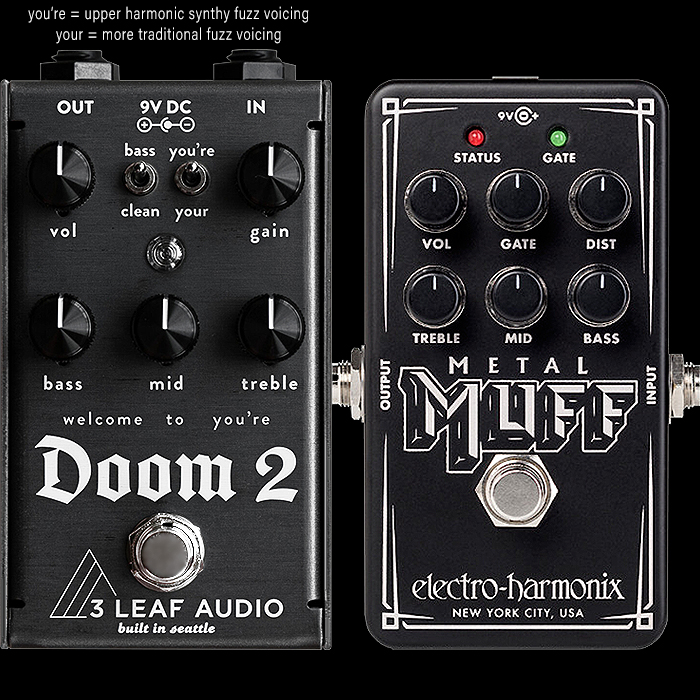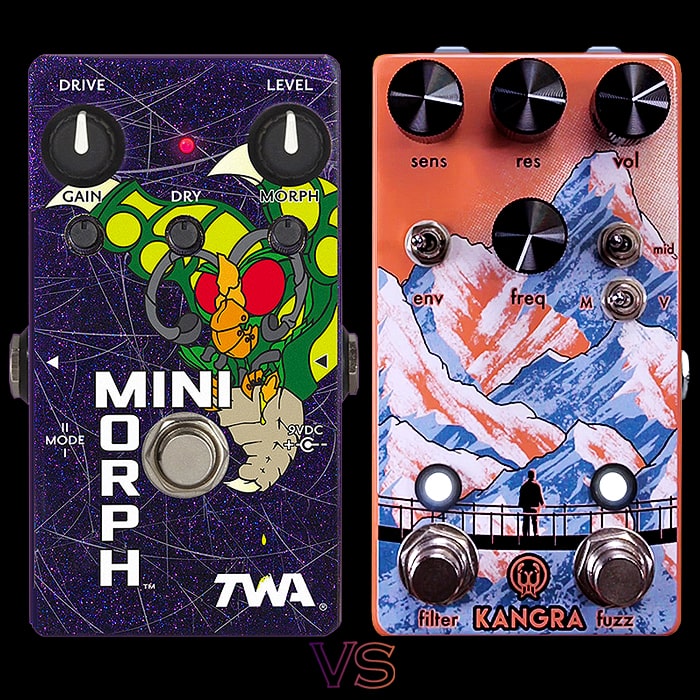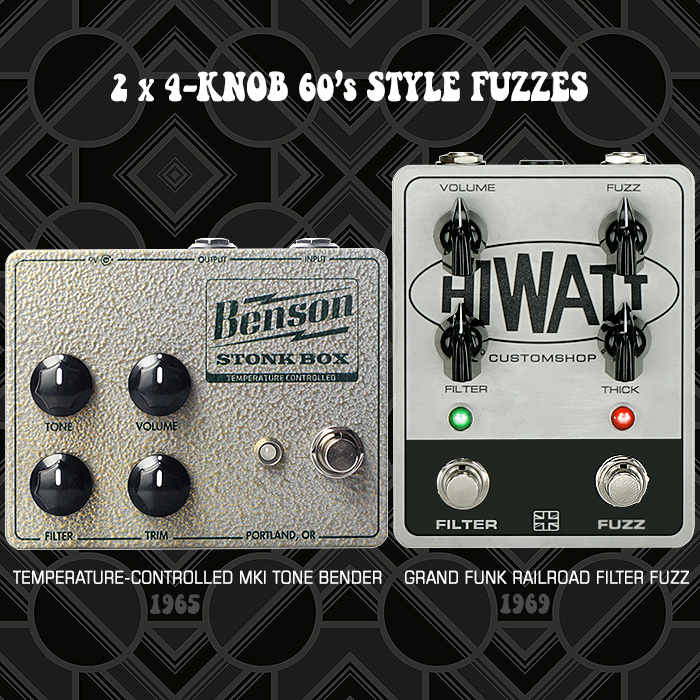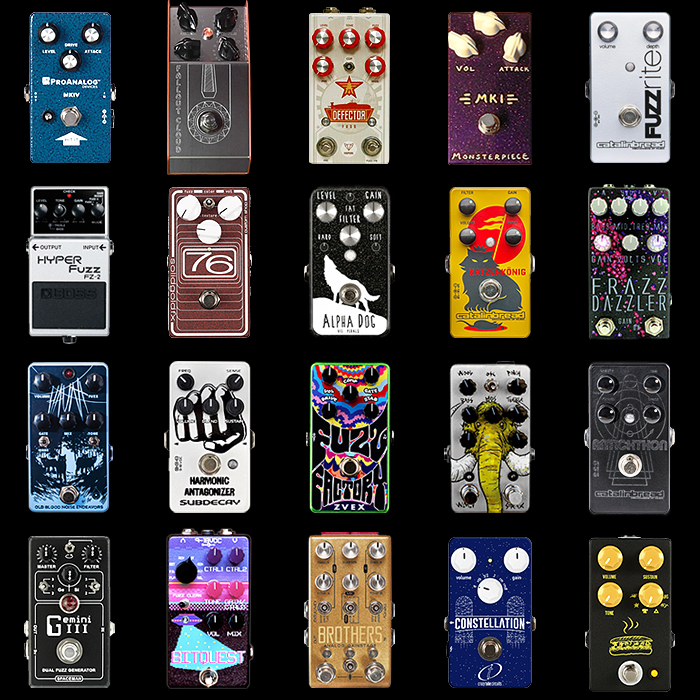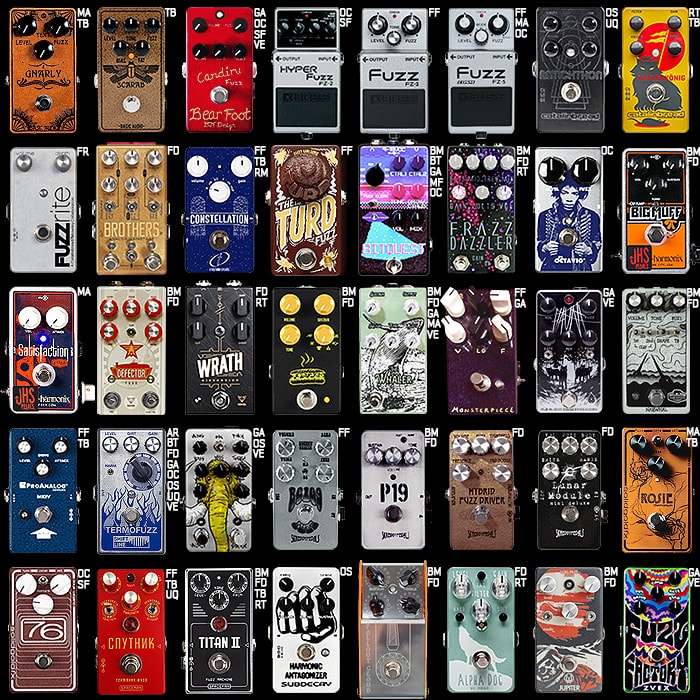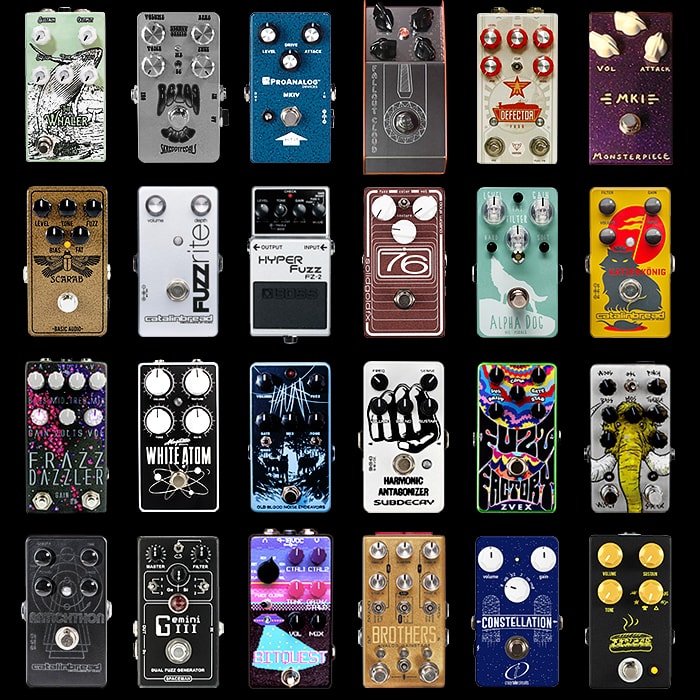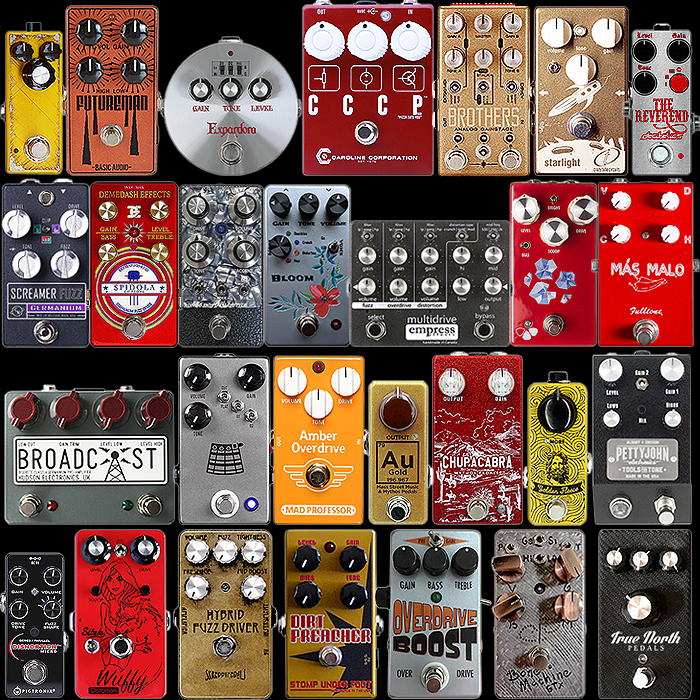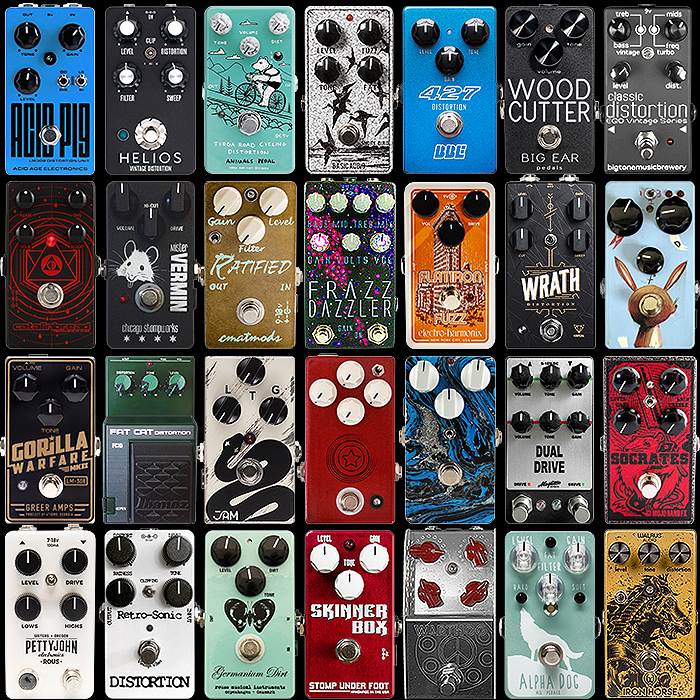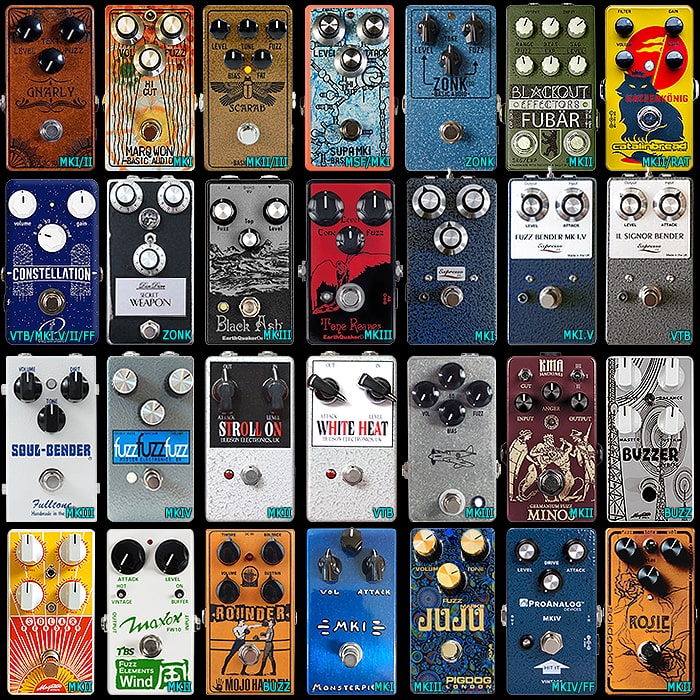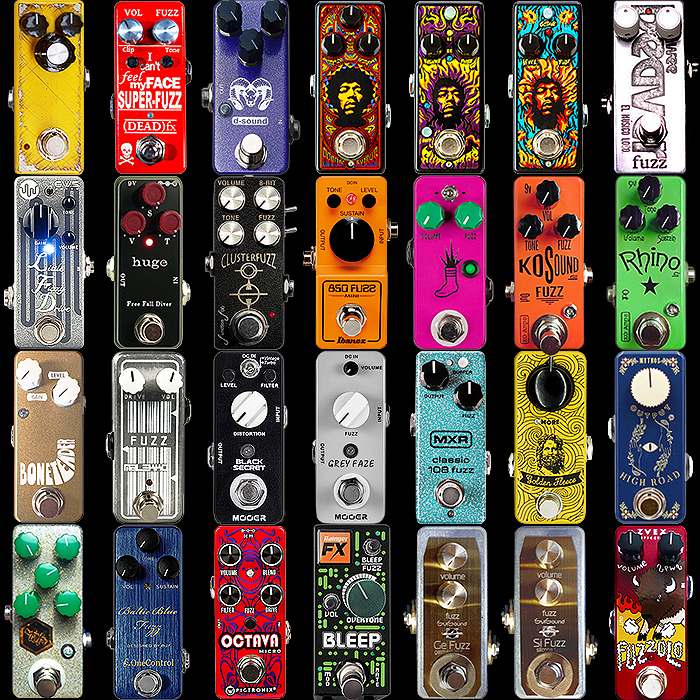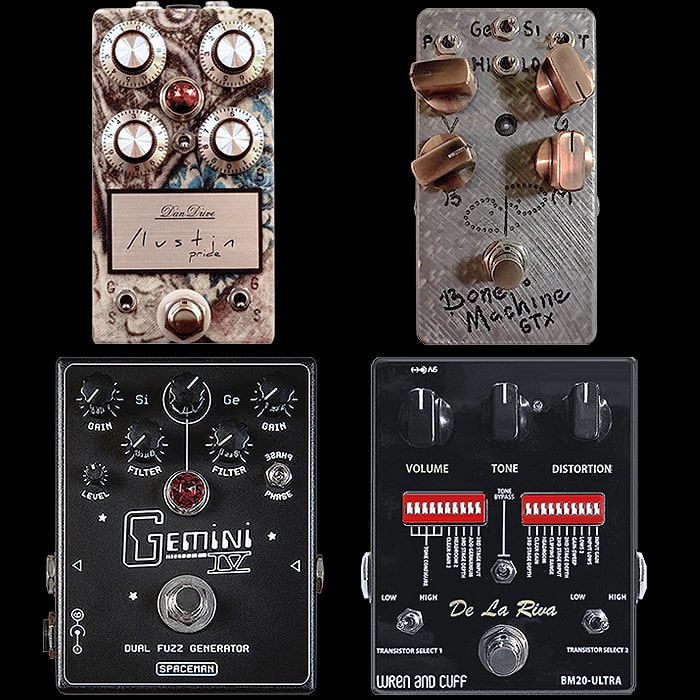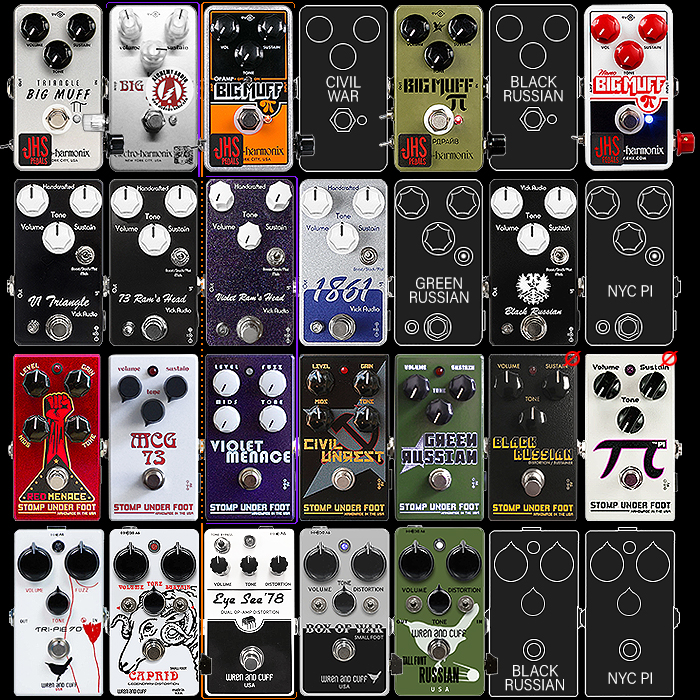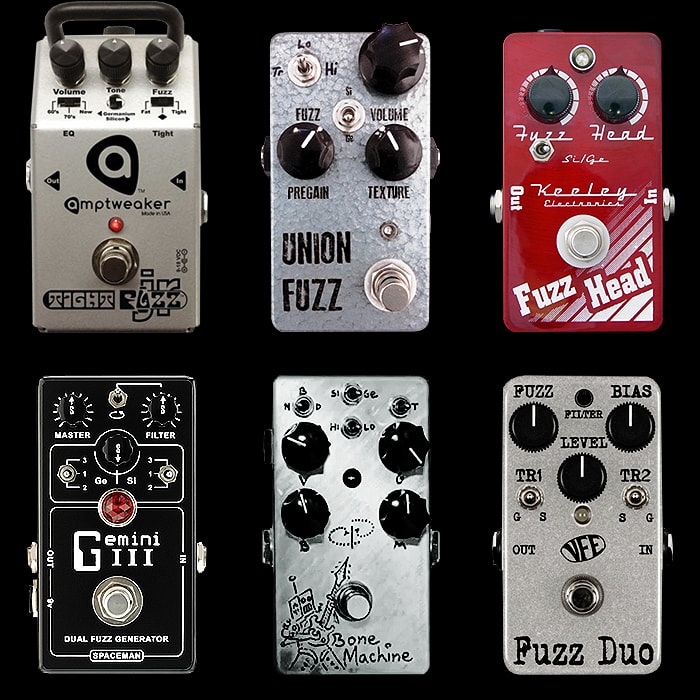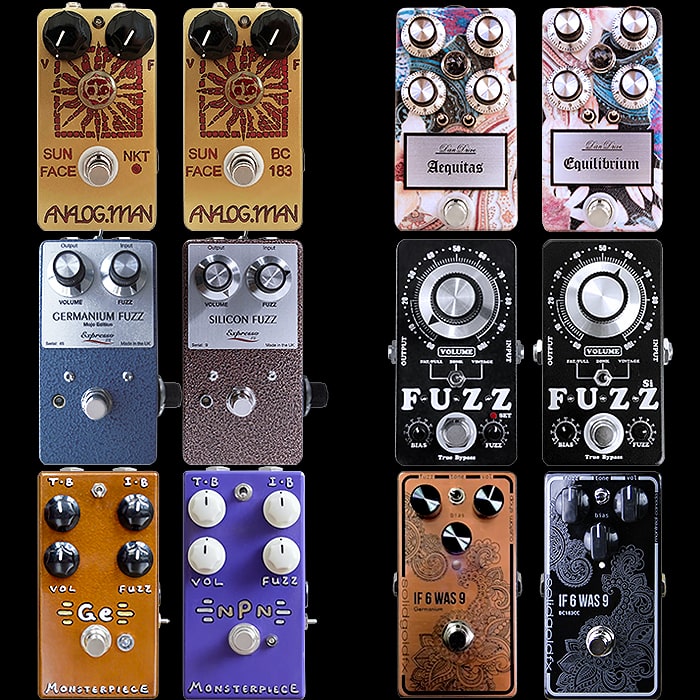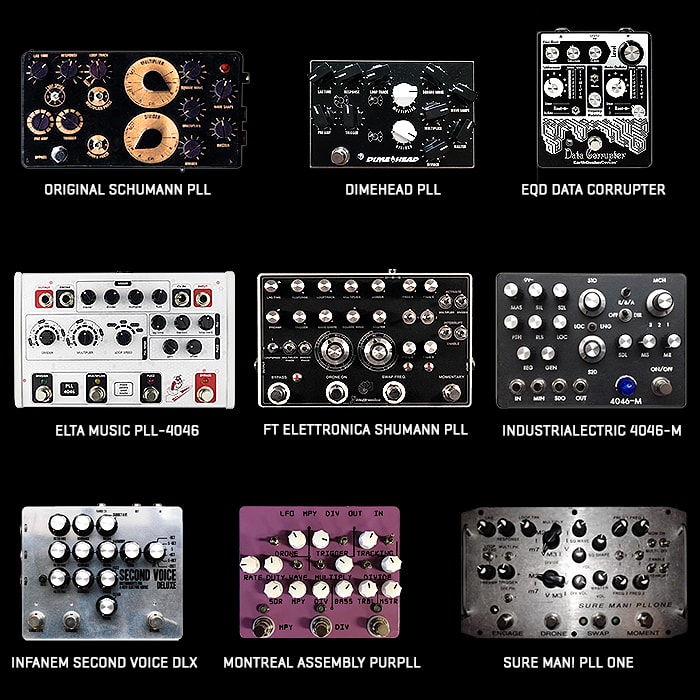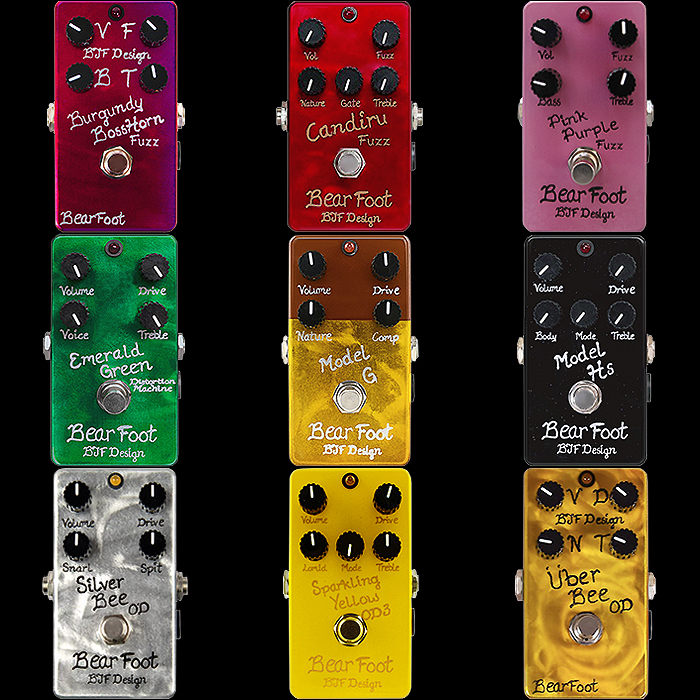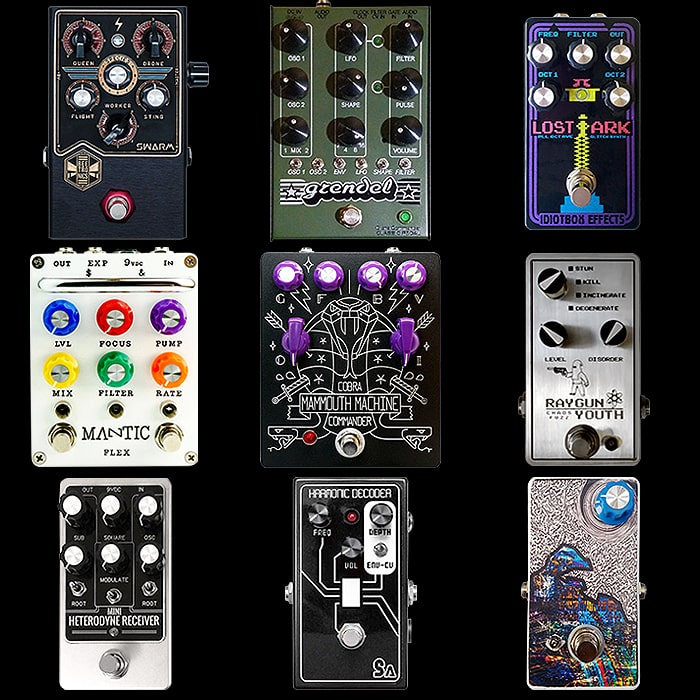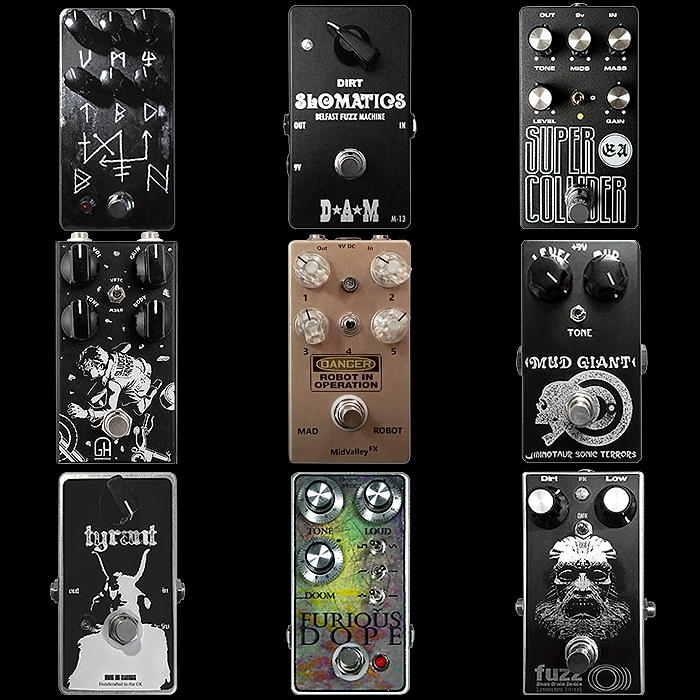Basic Audio Compact Pedals A to Z = 28+ Fantastic Flavours of Fuzz since 1998
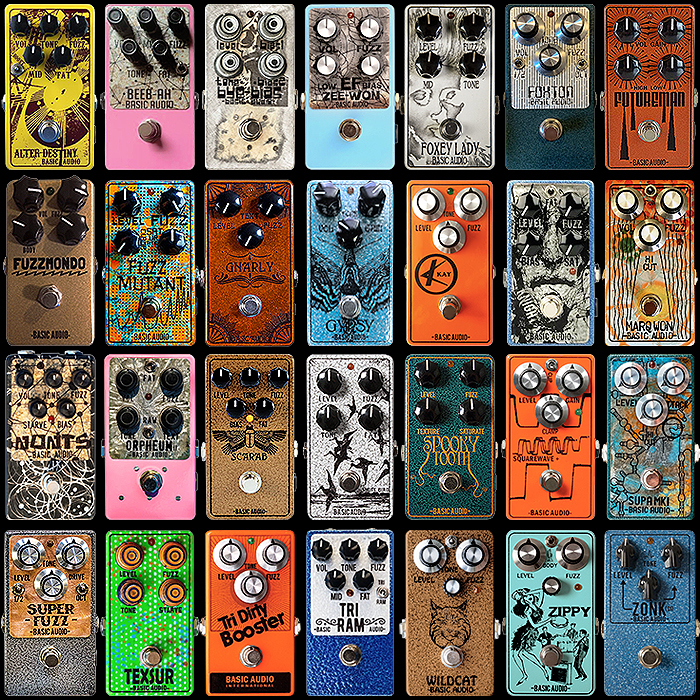
I’m not entirely clear on how I first got into Basic Audio / John Lyons, but I did get the Scarab Deluxe very early on in my Fuzz ToneQuest - followed then by the Futureman and Gnarly in rather quick succession, and leading to where I now have 11 from this very extensive and flavourful range. Update! I’ve just added the Foxton to make it 12 now.
I think if you are a fuzz fan like myself then you really cannot ignore John Lyons’ Basic Audio Fuzz Pedals - there is no broader range of fuzz pedals out there currently, particularly not in my preferred compact enclosure size - and overall John has produced over 50 varieties of highest fidelity fuzzes with tasteful and understated modern engineering innovations - and covering near enough every significant fuzz type there ever was while adding a few of his own in various beautifully appointed and designed enclosures.
When I first properly covered John Lyons as the ’Unsung King of Fuzz’ about a year ago - I listed what I believed were 9 of his best at the time, 8 of those are already in my collection along with 4 others, and only the Spooky Tooth is still outstanding from that original 9.
As noted in my last couple of related posts - I intended to acquire the Tri/Ram Muff Fuzz at an early stage but went for the all-rounder Alter-Destiny first as John described it as his Muff equivalent of his all-rounder Tone Bender Scarab Deluxe - which I still consider to be his flagship pedal. Then just this last Monday I became aware of the 5-knob Blue Hammerite Tri/Ram pictured above which I very recently acquired off Ebay. So now I sort of have a penchant for 5-knob Basic Audio Fuzzes above all others.
My current Basic Audio Fuzz Tone Library is a mini A-Z in and of itself:
- Alter-Destiny Fuzz (All-Rounder Big Muff)
- Foxton Octave Fuzz (Foxx Tone Machine)
- Futureman (Colorsound Power Boost / Overdriver)
- Fuzzmondo (Fuzzrite-ish Silicon Fuzz)
- Fuzz Mutant (Os Mutantes Regulus VII)
- Gnarly Fuzz (Maestro/Tone Bender)
- Marq Won Germanium Fuzz (Tone Bender MKI)
- Orpheum II Germanium Fuzz (Germanium Fuzz Face)
- Scarab Deluxe Fuzz (All-Rounder Silicon Tone Bender)
- Shore Bird Fuzz/Distortion (ProCo Rat)
- Tri/Ram Muff Fuzz (Triangle/Ram’s Head Big Muff)
- Zippy Fuzz (Shin Ei Fy-2/Reedy/Saxophone/Horn Fuzz)
It really took a very long time to settle on which 28 pedals I would feature from the extended range - where most of the pedals are priced at either $180 or $200, while the Wildcat can be had for just $160, and some of the Germanium varieties in particular go for a little more or $220 - the larger format dual pedals, special editions, custom builds etc. are of course dearer.
I really love each of my 12 Basic Audio Fuzzes - each has its own character and soul and while at times I might possibly have preferred a slightly different enclosure colourway, I’m actually delighted with all the ones I’ve ended up with so far.
I’m nowhere near completion of this particular odyssey as there is already an equal number of further Basic Audio Fuzzes I’ve marked out for acquisition, including one or two from beyond the featured 28:
- Beeb-Ah Fuzz (Roland Bee Baa Fuzz)
- Buzztone Fuzzy-Drive (Drive/Fuzz/Selmer Buzz Tone)
- Bye-Bias Germanium 5-knob Edition (Softer, Mis-biased, Starved, Crumbling Fuzz)
- Gypsy Fuzz (KR Musical Products The Gypsy Fuzz)
- Nonts (Silicon Baldwin-Burns Buzzaround)
- Spooky Tooth (Sort of Orpheum + Fuzzrite + Super Fuzz)
- Squarewave+ (Univox Squarewave)
- Supa MKI (Marshall Tone Bender MKI with Mids push)
- Texsur Fuzz (Hybrid Germanium/Silicon Jordan Bosstone)
- Tri-Dirty Booster (Honer Tri Dirty Booster Muff)
- Wildcat (Superfuzz-ish)
- Zonk (John Hornby Skewes Zonk Machine)
Of course I’m unlikely to acquire every one of these as life usually takes some interesting detours - but I definitely want the remaining 5-knob varieties and Tone Benders variants I don’t currently have. I dare say new priorities will arise and different opportunities present themselves but I feel that in a year or two more I could have acquired a very significant part of those featured pedals - of course time will tell ...
Featured pedals are listed alphabetically:
Alter-Destiny Hybrid Fuzz (All-Rounder Big Muff) - $200
As noted, this was the first of the Basic Audio Muffs I acquired ahead of the Tri/Ram which I also now have. Other notable Basic Audio Muff style Fuzzes include the Jumbo Tonebender, Foxey Lady, and Tri-Dirty Booster. The Alter-Destiny has 5 controls - Volume | Tone | Fuzz | Mids | Fat (Low End), with a 3-way Mids Boost switch which is flat in the middle, boosted when up, and super punchy when down. This is just a really fantastic versatile 70's style Muff with about as much tone-shaping as you can get - sounds great.
Beeb-Ah Fuzz (Roland Bee Baa Fuzz) - $200 (Est.)
I believe John is still prototyping his take on the Roland Bee Baa Fuzz - the latest version as pictured has 6 controls, 5 knobs - Volume | Mids | Fuzz | Tone | Fat, along with a Gain Cut toggle-switch. I'm a huge fan of the Bee Baa variety and already have and love the Anarchy Audio take on this format. I will no doubt spring for one of these as soon as they appear for sale - which should be later this year. Note - no demo video yet - will post when one materialises.
Bye-Bias Fuzz (Dual Bias Synthy/Zippery Fuzz) - $200
There's actually two versions of this Dual Bias-control Fuzz - the Silicon one pictured above with 4 controls - Level | Bias 1 | Tone | Bias 2, and a newer Germanium variant with 5 controls - Volume | Tone | Fuzz | Bias | Starve. I was in two minds as to which version to feature in the list of 28, and I'm equally torn on which version I prefer to acquire for myself - I'm a sucker for Germanium though, and I really like 5 knob control topologies and referenced above.
Ef-Zee-Won Fuzz (Gibson Maestro FZ-1) - $220
This is John's take on the pedal that started it all back in 1962. I personally prefer the Tone Benders that were based on a higher voltage (9V) more sustaining take on this circuit as engineered by Gary Stuart Hurst. That's not to say the FZ-1 / Ef Zee-Won doesn't sound great - the Gnarly in effect covers this pedal to a degree - kind of straddling the Maestro and Tone Bender tonalities. Here you get a very handy 4 controls - Volume | Fuzz | Low | Bias. Probably not my favourite type, but still a classic.
Foxey Lady Fuzz (Guild Foxey Lady Muff Fuzz + Mids) - $180
John's take on the Guild Foxey Lady Muff sounds articulate and vibrant - possibly I need this in the collection too! You get 4 controls here, with the Fuzz knob sometimes labelled as Sustain - Level | Fuzz | Mid | Tone. John improves a lot of these core circuits by enhancing them with further Mid and or Fat controls - so you get a great sounding fuzz which also works really well within a band mix.
Foxton Octave Fuzz (Foxx Tone Machine) - $200
I really like this pedal in half-gain mode per the above demo - it's quite disconcerting really that there are so many great Basic Audio pedals out there - it's probably too much to collect them all - but some tiny part of me really wants to! You get 3 dials - Volume | Tone | Fuzz - and two 2-way toggle switches for 1/2 gain, and Octave on/off. I wasn't sure I needed this variety, but I'm sorely tempted now after the above demo. In fact so tempted that this is now the 12th Basic Audio in the collection.
Futureman Fuzzy-Drive (Colorsound Power Boost / Overdriver) - $180
This was a somewhat serendipitous acquisition as I had just completed my Colorsound Power Boost style pedals overview and of those I really liked - this was the first I encountered on Reverb.com. I also included it in a separate piece on the Art of Dialling It In - where I advise that you need to crank the Gain and use your Guitar's Volume and Tone controls to further modulate / moderate the tone and texture. The pedal really needs to be cranked to get that rich texture these pedals were so loved for. You get 4 controls on the pedal - Volume | Gain | High | Low - with a lot of the action being defined at Gain 3 o'c to 5 o'c!
Fuzzmondo Fuzz (Fuzzrite-ish Silicon Fuzz actually based on 2-knob Foxey Lady) - $180
This was another serendipitous acquisition - I spotted it on Reverb.com, and did some quick research before snapping it up almost as rapidly. It has a lovely ripping raunchy tone to it - with tones of texture - like a slightly more balanced Fuzzrite with more depth to it. It's just another great sounding John Lyons classic here with 4 controls - Level | Fuzz | Body | Texture. It's not necessarily one of Basic Audio's most celebrated fuzzes - but it is quite dear to me!
Fuzz Mutant Silicon Fuzz (Os Mutantes Regulus VII Fuzz) - $180
This is a fantastic ripping high gain Silicon Fuzz Face variant which is also the same types as the Fuzz-side of my Abracadabra Audio Ayahuasca Trem-Fuzz. So I have a soft spot for the Os Mutantes Regulus VII which is hewn from the Fuzz Face but kind of sounds nothing like it really to some degree. You get 4 controls here - Level | Fuzz | Clamp | Saturate. With the 'Clamp' function acting as a sort of Bias Gate.
Gnarly Fuzz (Maestro / Tone Bender / Shin Ei Fy-2) - $180
John describes this as a cross between the Maestro FZ-1 and Shin Ei Fy-2 which ends up sounding sort of like a Silicon Tone Bender MKI - while I feel it sits also somewhere between a MKI and MKII. It has a lovely saturated core tone and plenty of variation from just 3 dials - Level | Texture | Fuzz. Oddly enough this is the Basic Audio that seems to have been getting most of the recent rotation action alongside the Zippy.
Gypsy Fuzz (KR Musical Products The Gypsy Fuzz) - $220
I believe this is John's take on the KR Gypsy Fuzz - which was in turn a reverse engineered replica of Hendrix's Band of Gypsys variant Dallas Arbiter Fuzz Face. In any case a pretty magical take on that fantastic Silicon Fuzz Face tone from Jimi's album of the same name. You get just the classic 3 controls - Volume | Tone | Gain - but that is all this pedal needs. This is another one which is on the heavy consideration list!
Kay Fuzz (Kay Fuzz Tone Octave Up Fuzz) - $200
A cool modern take on the somewhat cultish 60's American-made orange plastic-treadle Kay Fuzz Tone Octave Up Fuzz. Of course you don't get the original rocker control here, but just the 3 handy classic controls - Level | Tone | Fuzz. There is plenty of competition in the octave up fuzz stakes but this still manages to have its own distinctive character and timbre. I'm not sure I would have it over the Foxton for instance, but it's certainly another cool and slightly more unusual variety.
Knight Fuzz (Knight KG-389 Fuzz Box) - $180
This sligtly reedy / zithery sounding fuzz is based on the Knight KG-389 Fuzz Box and has its own distinctive voice amongst all these many varieties of fuzz. It has a very particular timbre and texture which I've warmed to quite a lot recently. The variety and verve of these Basic Audio pedals is somewhat overwhelming my senses these days. All these sound distinctive and each somehow uniquely appeals to me, and I really can't understand those who profess to hate the fuzz genre - when there is so much superb variety about. You get 5 controls here, 4 knobs - Level | Fuzz | Bias | Saturation, alongside a Fat toggle-switch to boost the lower frequencies. I initially really did not think I needed this, but now I'm not so sure!
Marq Won Germanium Fuzz (Tone Bender MKI) - $220
I currently have a pair of favourite MKI Tone Benders which actually sound slightly different but which I love equally. This warmer, noisier and more saturated Marq Won, and the slightly cooler yet searingly tuneful Expresso FX Fuzz Bender MKI. I seem to have a thing for MKI Tone Benders, as I'm considering adding a Monsterpiece MKI into the rotation too. There's no need really as the Marq Won and Fuzz Bender together cover all my favourite MKI sweetspots individually. You get 3 Knobs here - Volume, Fuzz and Hi Cut, along with a 3-way EQ toggle-switch for Thick/Thin/Stock varieties - I really like both Thick and Stock modes here.
Nonts Fuzz (Silicon Baldwin-Burns Buzzaround) - $200
John's take on the Buzzaround has undergone various iterations along the way which have brought it to its current format of 5 controls - Volume | Tone | Fuzz | Starve | Bias. I've always been a big fan of the Buzzaround circuit and would be very happy to add this 5-knob version to my Tone Library. There is no particularly great demo of this pedal currently available so the above video will have to do for now. You get some vague idea of the tonality of the pedal but not really its dynamics. The Buzzaround circuit is generally quite a dynamic and vibrant fuzz - which is not adequately revealed in the above video. As another 5-knob Basic Audio - this is definitely another I want in my collection.
Orpheum II Germanium Fuzz 4-knob (Germanium Fuzz Face+) - $200
This is probably my most recent Basic Audio addition which I acquired from a British collector. I would not necessarily have sought out the Pink version myself but it was the one what was available to me and I rather quite like it now. This is essentially a Germanium Fuzz Face with some extra bells and whistles via 6 controls - 4 knobs : Volume | Fuzz | Tone | Texture, and then two 2-way toggle switches - Fat (Low Boost) and Raw (High Cut). What you get here is just a monster versatile Fuzz Face type with extra range above and beyond more typical 2 and 3-knob varieties.
Scarab Deluxe Fuzz (All-Rounder Silicon Tone Bender) - $200
This was the first Basic Audio Fuzz I acquired, and I still consider it the quintessential Basic Audio Flagship Fuzz. With those 5 knobs you can tune in pretty much any and every variety of Tone Bender style fuzz - obviously some types more authentically / successfully than others - but its versatility in this genre is pretty much unparalleled. The 5 controls are Level | Tone | Fuzz | Bias | Fat - and while I've typically pinned it to MKII/MKIII coverage it really does extend beyond that to cover most of the core Tone Bender tonalities. I still feel that if you buy only one Basic Audio pedal - then this should be it - unless you are looking for a very specific Fuzz genre - obviously other than Tone Bender!
Shore Bird Fuzz/Distortion (ProCo Rat) - $180
I'm a big fan of Rat pedals in general and I currently have 15 different varieties in the collection including this refined variation. John has tweaked the overall profile to make it more even-handed across the gain spectrum - meaning you get a slightly better behaved Rat style distortion without the boomyness of the original. You have 4 controls at your disposal here or one more than the ProCo Rat - Level | Fuzz | Tone | Fat. I've been playing my 2 Jam Pedals Rattlers a lot recently so it's time I got this one back into the rotation again. I'm not sure this is my favourite ever take on the Rat format as I have several that I love - this one is definitely up there in contention though.
Spooky Tooth Fuzz (Sort of Orpheum + Fuzzrite + Super Fuzz) - $180
This is the one Basic Audio Fuzz from my first featured list of 9 that I've still to acquire. John describes the Spooky Tooth as a mix of the Orpheum, Fuzzrite and Super Fuzz - basically it ranges from mild to wild! The magic here is the combination of the Texture and Saturate knobs which are what elevate this Silicon Fuzz to another level. It's just a super versatile Fuzz which has legions of fans who profess it to be the best of Basic Audio. It's been on my wishlist for a while and I've just been waiting for the right one to come along - I would have thought this will be in the collection relatively soon too.
Squarewave+ Fuzz (Univox Squarewave) - $180
This squelchy mid-present Fuzz is distinctly different to most of the varieties featured here, and John is somewhat surprised this hasn't found more love as it cuts really well though the mix with a certain lively verve. Based on the Univox Squarewave this gives you 3 knobs - Level | Clamp | Gain - and a 'Clip' toggle switch which allows you to disable the Clipping. I certainly feel its somewhat unique timbre justifies its place in most fuzz collections - and I will be looking to remedy that at some point in the future.
Supa MKI Fuzz (Marshall Supa Fuzz / Tone Bender MKI with Mids push) - $220
This is one of the pedals that stood out in my recent 28-strong Tone Bender overview. Based on the Marshall Supa Fuzz - essentially an OEM'd Colorsound Tone Bender which started with the same components as the MKI and then evolved from there. This version is based on the MKI edition and features Level | Attack | Hi-Cut knobs. Again this is another variety I'm really interested in and will be looking to add to the collection soonish - depending on which variety I encounter in the wild.
Super Fuzz (Univox Superfuzz) - $200
I'm quite the fan of the 6-transistor Super Fuzz circuit, having 6 such 'takes' on this well celebrated variety already in the collection. As with many Basic Audio pedals I did not think I needed another such, but upon hearing the many demos - I'm certainly tempted. The controls are differently labelled but pretty much identical to the Foxton above - Level | Tone | Drive knobs, and then 1/2 Gain and Octave/No Octave switches. It has quite a different tonality to the Foxton - slightly more compressed and thick in texture. Possibly I slightly prefer the Foxton purely on tonal versatility, but I really like this one too. It's tricky for a fuzz fan really - you kinda sorta want them all!
Texsur Fuzz (Hybrid Germanium/Silicon Jordan Bosstone) - $200
I believe this is one of John's more recent circuits - a 4-knob take on the diminutive Jordan Bosstone - with tone-shaping courtesy of Level | Fuzz | Tone | Starve. You can get some interesting 'horn' tones out of this fuzz as I guess the vogue was for some of these early fuzzes. It certainly has a cool buzzy quality about it which had a certain appeal. I actually like this one quite a lot too, but have yet to decide if this is one of the flavours that I really need!
Tri-Dirty Booster Fuzz (Honer Tri Dirty Booster Muff) - $200
A pretty gloriously chunky Big Muff style circuit based on the similarly named Honer pedal. It features just the standard 3 controls - Level | Tone | Fuzz, so can't quite compete with my 5-knob Alter-Destiny and Tri/Ram versions, but the core tone here is really pretty sweet, and I feel this would be another good addition to my Muff genre Tone Library.
Tri/Ram Muff Fuzz (Triangle/Ram's Head Big Muff) - $200
So this is actually my second most recently acquired, but has yet to arrive from the USA - it's on its way! In my original list of 9 Basic Audio pedals I chose the Tri/Ram over the Alter-Destiny, but when time came to acquire one I read somewhere that John regarded the Alter-Destiny as the Muff equivalent of his Scarab Deluxe - and with 5 knobs plus a 3-way mids boost switch - that was the one I went with at the time. In fact only relatively recently did I realised that there were 5-knob versions of the Tri/Ram too - with the same control topology as the Alter-Destiny. And I encountered one such for sale on Ebay which I secured on this last Monday. The Tri/Ram obviously combines two of the best loved Muff flavours in a single pedal, and with the additional 'Fat' dial here, you have superb tone-shaping to match the beautiful core tones of this pedal. I don't know yet whether I will love this more than my Alter-Destiny - but I'm very glad I have both. As mentioned above, I will probably complete my Basic Audi Muff trifecta with the Tri-Dirty Booster. While I will likely end up with 5 Tone Benders - the Gnarly, Scarab Deluxe and Marc Won which I already have, and the Supa MKI and Zonk which I aim to get.
Wildcat Fuzz (Superfuzz-ish Wall-of-Sound Fuzz) - $160
Basic Audio's lowest cost fuzz just happens to be one of its most potent. It's sort of in the ballpark of a Super Fuzz - meaning high-gain, slightly compressed, thick and aggressive. But there is still a softer side to the pedal at lower Fuzz levels which yields a really pleasant textured overdrive. 3 knobs here - Level | Tone | Fuzz, along with a 3-way Mids switch which is sort of scooped to the left, flat in the middle and boosted on the right. This is one of those unsung and slightly under-the-radar Basic Audio fuzzes which though get snapped up very quickly whenever they appear on Ebay.com or Reverb. I will most definitely be getting one of these too some day soon.
Zippy Fuzz (Shin Ei Fy-2/Reedy Saxophone/Horn Fuzz) - $180
This was the one Basic Audio Fuzz I was after for the longest time - to generate those reedy saxophone and horn-style tones - and I finally tracked down a light blue edition in Japan of all places. The pedal market in Japan is actually really strong and I've obtained a number of gems from there over the years - courtesy of Ebay and Reverb.com. In any case for this Zippy Fuzzy you get 3 controls - Level | Body | Fuzz with a two-way 'Horn' toggle switch - where to get the best Saxy/Horny tones you set the switch to down, wind the Fuzz and Body dials almost all the way back, and crank the Level. In fact I also use a post-boost here too to raise the output volume somewhat and bring it to unity with the rest of my chain - and it delivers some really pleasing woodwind style sounds. It's quite understandable why the Zippy is so aftersought, while there is some parity here too with the Texsur - although the Zippy is somewhat smoother with its horn/sax tones - I really like it, and it's getting plenty of rotation these days.
Zonk Fuzz (John Hornby Skewes Zonk Machine) - $180
This is the 5th Tone Bender style variety I still really need to get my hands on - based on the John Hornby Skewes Zonk Machine - which was itself very close to a Tone Bender MKI. I really like all 5 Basic Audio Tone Bender style Fuzzes and have 3 of those already - with the Supa MKI and Zonk still to get. You just have the 3 classic controls here - Level | Tone | Fuzz.
Other Basic Audio Compact Enclosure Fuzzes
As I said at the top, it took me quite a long while to settle on my final selection of 28 featured pedals - several were a dead cert, while for others I could have gone either way with a number of these. Note that some of these are iterations along the way to the final models, others are totally different variants, some of these have yet to materialise fully, while others are definitely semi- or fully retired.
I tried to be all encompassing here, but no doubt I have inadvertently omitted one or two - which I can add in here if someone is nice enough to let me know:
- Buzz Fuzz (Baldwin-Burns Buzzaround)
- Buzzin' Sound (Reworked Baldwin-Burns Buzzaround)
- Buzztone Fuzzy-Drive (Drive/Fuzz/Selmer Buzz Tone)
- Bye-Bias Germanium 5-knob Edition (Softer, Mis-biased, Starved, Crumbling Fuzz)
- Clean Octave Blend (Prescription Electronics C.O.B.)
- Dot Fuzz (Hybrid Silicon/Germanium Fuzzrite)
- Double Beat Fuzz (Roland Double Beat Fuzz Wah)
- Drive Over Intermod (Modulated Fuzz)
- Duplex Fuzz (Dumble)
- Electric Mud (Jordan Bosstone)
- Expand Aura Fuzz/Drive/Distortion (Bixonic Expandora)
- Fuzz Face (Silicon Fuzz Face)
- Fuzzstainer (Sam Ash Fuzzstainer)
- Jumbo Tonebender (Big Muff)
- Knew Fuzz/Nu Fuzz (Undefined Fuzz variant)
- Low Volt (Tortured Germanium Zippy Fuzz with Extras)
- Lucky Number Fuzzy-Drive (Fuzz/Overdrive/Distortion)
- P-Fuzz (Gretsch Contro-Fuzz)
- Pale Rider Fuzz (Spaghetti Western 60's Style Fuzz/Fuzzrite)
- Peak Freq. (Filter Fuzz)
- Pep Fuzz (WEM Rush Pep Box)
- Pirk Fuzz/Distortion (Harmonic Percolator)
- Professor Fuzz Blend Unit
- Right Fuzz (Germanium Fuzzrite)
- Solar Myth (Smooth Silicon Fuzz Face)
- Standard Fuzz (Ibanez Standard Fuzz)
- Sunn Buzz Fuzz (Maestro FZ-1 Variation)
- Supa Fuzz (Marshall Tone Bender Supa MKI predecessor?)
- Warp (Pearl Vorg F-502 Warp Sound)
Other Basic Audio Compact Enclosure Non-Fuzz Pedals
John of course makes more than fuzzes and he has a variety of overdrive and distortion circuits, along with some modulation:
- 386 Overdrive (Sonic Titan)
- Auto Filter
- Distortion Booster (Vox Distortion Booster)
- Overtdrive (Textured / Fuzzy Overdrive)
- PFOD / Professor Fuzz Overdrive (Hofner Buzztone/Fuzzy Overdrive)
- Screamer (TS808)
- Throbby Tremolo (Sinewave Amp-style Tremolo)
- Wah (Auto Wah)
Key Over-Sized / Medium and Large Enclosure Basic Audio Pedals
A number of John's earlier pedals were made in bigger medium-style and above enclosures, and there have been a number of mostly custom dual-fuzz varieties featuring two of his circuits side-by-side in larger format boxes, including:
- Bee Baa-Boost Fuzz (Roland Bee Baa Fuzz)
- Chimp Blender (?Fuzz)
- Civil War Muff Fuzz
- Dirt Halo Fuzz (EarthSound Research Graphic Fuzz)
- EQ Exciter Fuzz
- Fender Blender Fuzz
- Gonzo Fuzz
- Halo-Ranger Fuzz
- Messenger Fuzz (Tone Messenger Guitar Fuzz)
- Phase (Phaser)
- Ring Modulator
- Sagan Skyripper Fuzz + Boost
- Scram! Fuzz (Ampeg Scrambler)
- Sonic Reiteration Device Fuzz
- Super Fuzz
- Teese (Fixed Wah)
- Weird Horus Deep Echo Chorus
Final Thoughts
With all this general outpouring of love and respect for all things Basic Audio and John Lyons, I'm still going to kick this final roundup off with a couple of negatives. Firstly I don't feel John's website really does him justice at all - there are several pedals not listed / featured on there - he should definitely have an archive of his past successes too - much like Marc Ahlfs / Skreddy does - and each pedal should be accompanied by better descriptions, pictures / references / collateral and demo videos really in a more user-friendly and comprehensive way than is done currently.
The YouTube / demo-video side is another element that is a touch patchy and could really do with significant improvements - there are some pretty cool ones out there, and I really like the David Torn trippy visual ones - but feel they may be a touch an acquired taste and not give Basic Audience the wider audience it fully deserves. Several pedals could do with better demo videos for sure - while I guess there is enough out there to get you interested - you just have to join up a lot of the dots yourself and I fear a number of potential customers might get lost along the way.
As I've said in the intro - I own 12 Basic Audio pedals to-date which is the same number as I have from each JHS (albeit mostly JHS Mods), TC Electronic and Wampler are 3rd with 11 apiece, while Boss in in the lead for me with 16 pedals all told. I feel longer-term it will be touch-and-go between Basic Audio and Boss as to who has the most in my collection - as I have certain several more pedals I firmly intend to get from each maker along the way.
I'm not entirely sure how I latched onto Basic Audio initially - as representation on this side of the pond is fairly lacklustre - I think we're down to just one dealer in GuitarFXDirect.com who rarely have any pedals in stock, and certainly not any of the more interesting ones. The same story is true of most dealers / reseller - in that there are only very few pedals in stock at any given time despite some sites superficially covering a much larger range - a similar issue I've always had with Skreddy Pedals and many more of this ilk.
You can always of course order direct from John via the BasicAudio.net website - but that means waiting around for your pedal to be built and shipped - and my lack of patience often gets in the way of said direct approach - but it may be the only way of my getting hold of some of the pedals I'm after.
I am juggling so many priorities nowadays that I usually feel more at ease putting out feeders on Ebay and Reverb.com and waiting for likely suspects to appear on my radar. I've pretty much acquired all bar a couple or so of my Basic Audio pedals in this manner. I actually quite enjoy the chase in that way - but would still like for these pedals to be more readily available - which I'm aware isn't totally practical as they're still built by hand in very limited quantities.
The purpose of this post is to remind myself and others just how many great Basic Audio Fuzz pedals there are out there in the world - and to bear those in mind when considering new pedal acquisitions. Basic Audio is easily my most significant Fuzz Pedal Purveyor and I believe will continue to be so - no one else does as many great flavours as John does. I feel possibly the only Fuzz John hasn't done his version of yet is the Sam Ash Fuzzz Boxx / Astrotone Fuzz - although I'm aware there are lots of individual iterative varieties you could cite here too - but basically no one gives you more fuzz!
I really like the form factor here, and the modernisations/ innovations of the circuits - meaning that you don't have to use reverse-polarity power for certain genre types, and you can place most of the Germanium Fuzzes pretty much anywhere in your chain. I feel that John gets the balance just right between traditional artisan fuzz craft and modern innovation - and a number of the enclosures - especially the ones which sport custom knobs - are ever so aesthetically appealing too. I feel every fuzz fan should have a Basic Audio pedal or two - start with the Scarab Deluxe like I did, or try the Orpheum if you like Fuzz Faces and Alter-Destiny or Tri/Ram if your preference is for Muffs - or anything in-between and beyond really. I also like several of the more niche fuzzes here like the Texsur and Zippy.
All of my Basic Audio pedals sound great and are amongst the finest of my now 160 strong or so Fuzz Tone Library. I've no idea of knowing how many Basic Audio pedals I'm likely to acquire over these forthcoming years, but I feel it will be fairly significant number - perhaps it's time to get in touch with John after all. I would love to know which of you collect Basic Audio too - and which are your favourites?
Update 4 -! My Basic Audio Collection now currently stands at 19 !:
- Alter-Destiny Fuzz (All-Rounder Big Muff)
- Foxey Lady Fuzz (Guild Foxey Lady Muff Fuzz)
- Foxton Octave Fuzz (Foxx Tone Machine)
- Futureman (Colorsound Power Boost / Overdriver)
- Fuzzmondo (Fuzzrite-ish Silicon Fuzz)
- Fuzz Mutant (Os Mutantes Regulus VIII)
- Gnarly Fuzz (Maestro/Tone Bender)
- Gypsy Fuzz (KR Musical Products The Gypsy Fuzz)
- Marq Won Germanium Fuzz (Tone Bender MKI)
- Nonts (Silicon Baldwin-Burns Buzzaround)
- Orpheum II Germanium Fuzz (Germanium Fuzz Face)
- Scarab Deluxe Fuzz (All-Rounder Silicon Tone Bender)
- Shore Bird Fuzz/Distortion (ProCo Rat)
- Spooky Tooth (Neil Young Fuzz)
- Supa MKI (Marshall Tone Bender MKI with Mids push)
- Tri/Ram 5-knob Muff Fuzz (Triangle/Ram’s Head Big Muff)
- Willdcat (Gretsch Control Fuzz)
- Zippy Fuzz (Shin Ei Fy-2/Reedy/Saxophone/Horn Fuzz)
- Zonk (Si) [II] (JHS Zonk Machine II)



















